Triptych (Triptyque) (Robert Lepage, Pedro Pires, 2013): Canada
Reviewed by Daniel Chein. Viewed at SBIFF.
Based on the short blurb about the film in the festival guide, I knew I was going to like this film. It read: Triptych (Triptyque) – The lives of three characters intersect in a sublime narrative geometry within this haunting adaptation of Rober Lepage‘s celebrated theater work, Lipsynch. Directed by Lepage and his partner Pedro Pires, this film follows a alcoholic brain surgeon and two sisters–one is a schizophrenic poet, the other a jazz singer who loses her words. Just from the description of the characters, it is evident that drama and paradox is built into this story.
What was unique about this film is its experimental narrative structure that plays with the perception of time. The film is broken into 3 chapters, with each one focusing on a different character: Michelle (Lise Castonguay), Thomas (Hans Piesbergen), and Marie (Frédérike Bédard). Michelle is released from a psychiatric hospital and seeks refuge from society at her sister’s house, where she meets Thomas, a brain surgeon specializing in psychiatric disorders. Michelle finds out, and suspects Marie of setting up their meeting so that she might try some new medication. Meanwhile, Marie goes in for a routine checkup and discovers she has a brain tumor that needs to be removed. Thomas explains that the region of the brain the tumor is located in affects your speech and memory, which is troubling to Marie as she makes her living as a singer. But even Thomas is not excused of a prevailing challenge. Recently, he has developed a tic in his hand, jeopardizing his client’s lives and his own career.
Triptych also uses some very creative shots and sounds to convey a sense of derangement. For Michelle, a lot of shots are distorted by glass or mirrors, and the viewer is left to interpret if what is shown on screen is what Michelle sees or is what is actually happening. She also hears voices in her head, which also intrude into the space of the screen. The coloring is very flat, adding to the sense of a dull and senseless world. As for editing, there are many cuts that don’t necessarily match or preserve continuity. Rather, some cuts are intended to compare and contrast composition, texture, or movement.
After the screening, the director and producer were present for a Q + A. Triptych actually started out as one short film about one character because that was all the funding they could secure. But after the first short was produced, Lepage insisted on creating the other two shorts. It wasn’t until all three shorts were created that Pires cut them together into a feature. Each short was shot in a different city during a different season, adding to the unique identity of the film. Another interesting fact is that the three characters from the film were the same actors/actresses that were casted from the stageplay. Castonguay, Piesbergen, and Bedard all contributed to the writing and creating of their respective characters, which to me really makes this piece a true work of art. If you are someone who likes experimental narrative/art films, this is a must see.
About this entry
You’re currently reading “Triptych (Triptyque) (Robert Lepage, Pedro Pires, 2013): Canada,” an entry on Student Film Reviews
- Published:
- 02.11.14 / 5pm
- Category:
- Films, Santa Barbara Film Festival 2014

No comments
Jump to comment form | comments rss [?] | trackback uri [?]